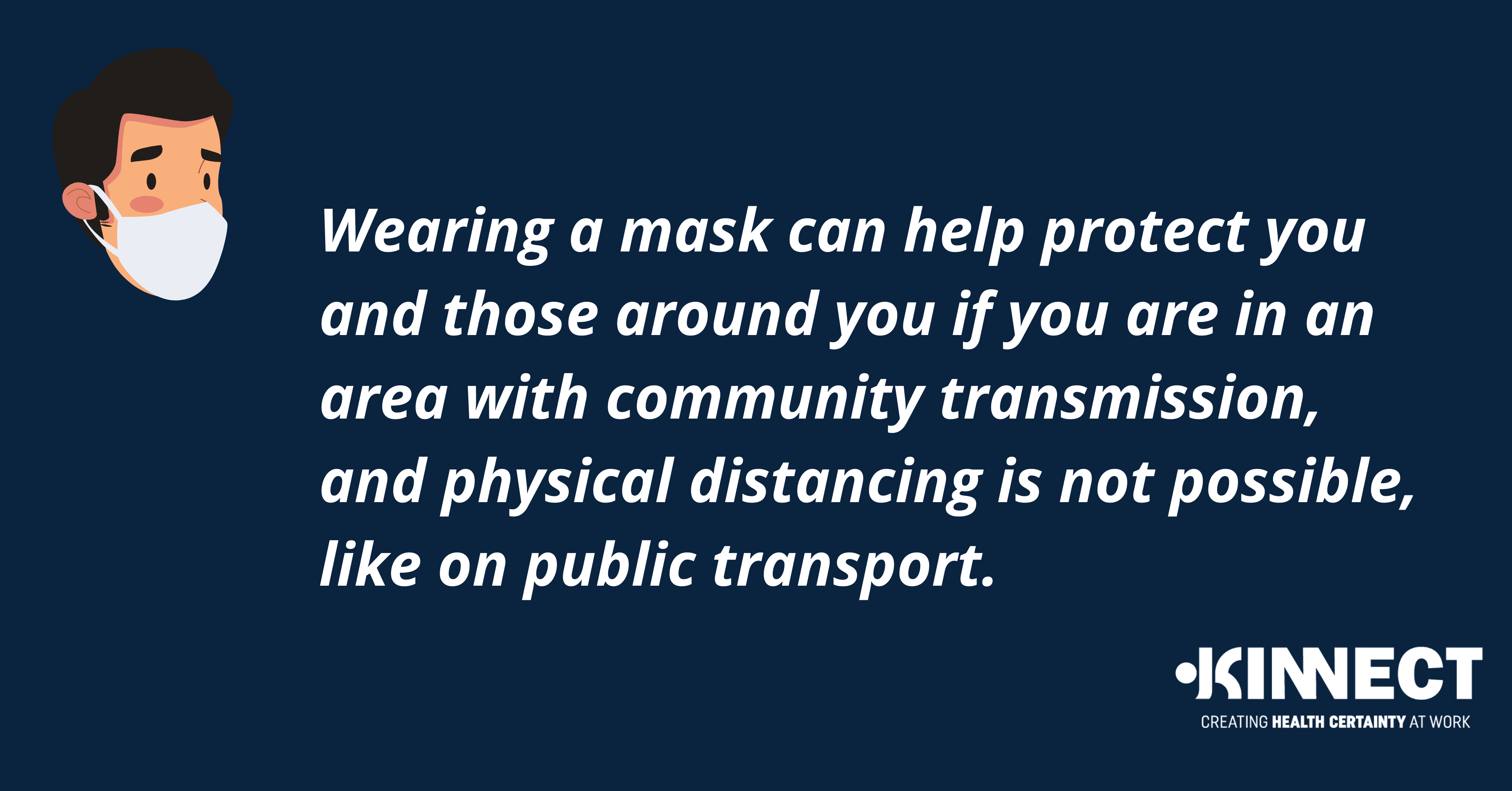Due to the recent outbreak of COVID-19 and the high level of community transmission in Victoria, from 11:59PM on Wednesday (22 July 2020) it will be mandatory for all people to wear a face mask when in public. Dr. Graeme Edwards (Senior Occupational and Environmental Physician, KINNECT) has prepared the below guidance material to advise KINNECT clients on what they should be doing within their workplace.
Wearing of Face Masks / bandannas / cloth coverings
To manage your workforce needs, the onus is on the business to incorporate changes as and when necessary. NOW is the time to review your business continuity plan and specifically re-assess the types of facial covering (i) available to you (check your supplies and supply lines), and (ii) review which workers might need to wear what type of respiratory protection.
Mitigating the risks of workplace transmission
Respiratory protection when travelling to and from work is a strategy to complement our strategies to deter, detect and deal with fairly, workers who are unwell, supporting them to stay at home. Advice to workers travelling to and from work, or for work, relies on employers addressing their continuing obligation to undertake, and continually review their risk assessment with specific reference to their COVID-19 business continuity planning.
Remember a workplace acquired infection is a compensable injury. You have an obligation to do all that is reasonably practical to protect the health and wellbeing of your people. Depending on jurisdiction, strategies to mitigate the risks can also protect or mitigate your future liabilities.
What to wear depends on the level (higher, lower, and low levels) of community transmission AND the risk within specific groups of people. “Low” means there is a continuing risk of an outbreak or cluster, due to family or site-related transmission, and where there is little evidence of community transmission. Remember, in Australia, the “first wave” of COVID-19 was almost exclusively transmission associated with the return traveller, or a health or residential-care facility. What we are seeing in Victoria is a ‘first wave of community transmission’ in Australia. In NSW, the agencies are actively attempting to stop the site-specific outbreaks from generating community transmission.
The standards of respiratory protection:
Respiratory protective devices are rated P1, P2 and P3 depending on their filtering efficiency (Australian and New Zealand Standards AS/NZS:1716). Surgical masks are also rated and must be approved before use in a medical setting by Australian Register of Therapeutic Goods (ARTG) as Level 1, 2 or 3 based on their moisture or splash resistance (AS/NZS 4381).
In practice, due to the nature of the droplet size, Level 2 and Level 3 surgical masks have a P2 equivalent filtering capacity without the tight facial seal to inhibit airflow contamination. Fit testing, and training in fit checking is necessary if P2 level respiratory protection is required.
When there is community transmission, any protection is better than no protection, so unrated commercial or home-made devices can be useful.
Lessons from Victoria:
Based on Victoria Government’s advice concerning the level of community transmission, I offer the following recommendations:
- People who are identified at increased risk (e.g. as identified through KINNECT’s COVID-19 Health Risk Survey) are strongly encouraged work from home if able, and to wear a Level 2 surgical mask or above (i.e. P2 or N95 disposable respirator equivalent) when travelling outside their residence for approved purposes.
- For all other people who do not require specific respiratory protection due to the nature of their work, a dust, non-surgical mask, facial scarf or bandanna, up to a P1 or Level 1 Surgical mask, when travelling or moving outside their residence, is sufficient; and will be mandated in metropolitan Melbourne and the Mitchell Shire. This mandate will be enforced after 11.59pm on Wednesday 22 July.
- Outside the designated higher risk regions (as defined by the Public Health Authorities), the lower level of community transmission across Victoria means that face coverings are not “mandatory”, but “recommended” to be worn in any situation where the physical distancing (minimum 1.5 metres) cannot be assured.
Outside of Victoria:
The advice about wearing masks in the community has been the same since the pandemic began: it is “not generally recommended”. https://www.health.gov.au/news/should-i-wear-a-face-mask-in-public

Outside Victoria the level of community transmission is still considered “low”. The low level of community transmission means that face coverings are not “recommended”, rather it is an individual choice. That choice must be influence by your business continuity planning.
If your business continuity is “at risk”, face covering should be actively encouraged in any situation where the physical distancing (minimum 1.5 metres) cannot be assured.
If you are an essential service, workers should be mandated to wear respiratory protection in such circumstances. Consider, the upskilling your team leaders, supervisors, and health and safety representatives to “COVID-19 Defensive Champions” to reinforce the need for compliance with safe systems of work.
If you have workers who reside near or travel through hot-spots outside of Victoria, a tool box talk or daily briefing session is recommended. This will allay at least some of their anxiety and invite questions about the role of respiratory protection for your workforce.
As always, use the advice of your local Public Health Authorities as a minimum, not an absolute.
Be alert, stay safe, and remember the basics: site hygiene, hand-oral hygiene and cough etiquette, and physical distancing.
Author
This article was prepared by Dr. Graeme Edwards on 15th June 2020. Dr. Edwards is a Senior Consulting Physician with extensive experience in Occupational and Environmental Medicine.
Need Further Advice?
Should you require additional advice on COVID-19 Workplace Risk Management Strategies, please contact us on 1300 546 632 or speak with you KINNECT Account Manager.



